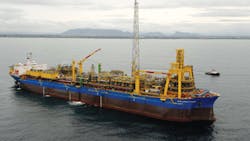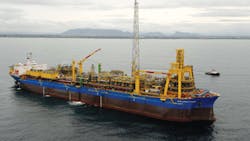Jessica Tippee
Assistant Editor
Despite political and corruption scandals, Brazil continues to dominate oil and gas exploration, development, and production offshore South America.
In the presalt Santos basin, Petrobras started up an early production system (EPS) on the Sépia (ex-Nordeste de Tupi) area. The operation is under way from the FPSOCidade de São Vicente, 185 km (115 mi) offshore the Rio de Janeiro coastline, which will produce around 20,000 b/d of oil during the test period. The main goals are to collect technical information on the behavior of the reservoirs and outflow of the oil via the underwater pipes to support development of the definitive production system, scheduled to start operations in the area in 2020. The vessel, installed in a water depth of around 2,200 m (7,219 ft), is connected to the 1-RJS-691 well. This is the company’s fourth EPS in the “Onerous Assignment” area of the Santos basin. Produced oil (26° API) will be transported by shuttle tankers.
The company also began operations at the FPSOCidade de Maricáon the Lula field (Lula Alto area). The facility, the seventh production system in the presalt Santos region, is moored 270 km (168 mi) offshore in a water depth of 2,120 m (6,955 ft). It can produce up to 150,000 b/d of oil and 6 MMcm/d (212 MMcf/d) of gas.
The first four production systems, installed between 2010 and 2014, are operating almost at full capacity of 475,000 b/d, via 19 producing wells, according to Petrobras. The three most recent platforms are delivering 205,000 b/d from seven producing wells.
Later this year the company expects the FPSOsCidade de SaquaremaandCidade de Caraguatatuba to start operating respectively in the Lula Central and Lapa areas in the BM-S-ILL concession.
Petrobras also recently activated the Route 2 pipeline, the second transportation route for gas from the presalt Santos basin. The 401-km (249-mi) system is the longest subsea gas pipeline in operation in Brazil with capacity to transport 13 MMcm/d (459 MMcf/d) of gas. Production heads to the gas treatment terminal at Cabiúnas in Macaé, Rio de Janeiro, where processing capacity has been increased to 28.4 MMcm/d (1 bcf/d) to receive supplies from the Santos and Campos basins. Route 2 will be connected to the Route 1 pipeline, which entered service in 2011, lifting total installed capacity for transportation of Santos basin presalt gas to 23 MMcm/d (812 MMcf/d).
The Libra consortium recently completed drilling and evaluation of two wells in the northwest area of the Libra block in the presalt Santos basin. According to operator Petrobras, well 3-BRSA-1305A-RJS (3-RJS-739A) intersected a 270-m (886-ft) oil column and confirmed 28° API oil. In addition, well 3-BRSA-1322-RJS (3-RJS-741) delivered good-quality oil (28° API) in reservoirs with strong productivity. It also delivered the biggest oil column encountered to date in the concession, 301 m (987 ft) thick. The similar reservoir characteristics and oil quality may indicate interconnection of the reservoirs. Partners in the Libra consortium are Shell, Total, CNPC, and CNOOC. Contract manager is Pré-Sal Petróleo S.A.
In the deepwater Campos basin, Shell and partners ONGC and Qatar Petroleum International have started oil production from the third phase of the Parque das Conchas (BC-10) development. Eventually this final phase of the project is expected to deliver a further 20,000 boe/d through the FPSOEspirito Santo, 150 km (90 mi) offshore. Phase 3 comprises five producing wells on the Massa and O-South fields and two water-injection wells, in water depths of more than 1,800 m (5,905 ft).
Farther south, Total started production from the Vega Pleyade gas and condensate field in the Tierra del Fuego region offshore Argentina. The facilities, designed to produce 70,000 boe/d, consist of a wellhead platform in 50 m (164 ft) of water, tied back via a 77-km (48-mi) offshore pipeline to the Total-operated Rio Cullen and Cañadon Alfa onshore treatment facilities. Construction was completed in two and a half years.
Arnaud Breuillac, president exploration and production, said: “The project consists of the development of one of the largest offshore gas fields in Argentina and is the world’s southern-most gas development. It will allow us to maintain the level of our operated production in Tierra del Fuego at around 130,000 boe/d and to contribute to the long-term delivery of gas to Argentina.”
Vega Pleyade is in the Cuenca Marina Austral 1 concession which Total operates with a 37.5% interest, in partnership with Wintershall Energia (37.5%) and Pan American Energy (25%).
Offshore the Falkland Islands, Premier Oil and Rockhopper Exploration have completed definition of the Phase 1a development of the Sea Lion oil field. This will target 220 MMbbl, focusing on the northwest part of the field, with peak production of 85,000 b/d. Thirteen of the 18 planned wells will be drilled before first oil in 2020. SBM Offshore is working on front-end engineering and design (FEED) for a converted FPSO to be stationed 220 km (137 mi) offshore in the north Falkland basin. Subsea 7 won the FEED contract for subsea umbilicals, risers, and flowlines transport and installation. National Oilwell Varco was awarded the flexibles FEED contract. Pre-first oil capex is estimated at $1.8 billion. The partners have submitted a draft field development plan to the government and are targeting a final investment decision in mid-2017.
Offshore Uruguay, Statoil has increased its exploration acreage in the deepwater Pelotas basin. The company agreed to acquire a 35% interest in block 15 from operator Tullow Oil. Block 15 covers more than 8,000 sq km (3,089 sq mi). INPEX is the other partner. Tullow has completed a comprehensive data collection program over the block, and the company plans to acquire further 3D seismic before deciding on the next steps. Statoil also joined operator Total and ExxonMobil in the 6,690-sq km (2,583-sq mi) block 14. Total’s program over the block to date includes newly acquired 3D seismic data. The partners are preparing to drill a first well on the Raya prospect in the coming months.




